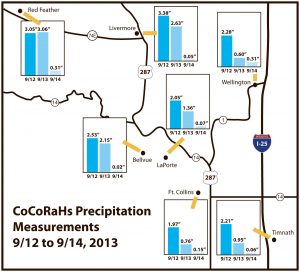Want to be a scientist? The answer to that question will depend on your personality. You don’t need to be brilliant, conversant with esoteric topics in nuclear physics or molecular biology, or look good in lab coat white. A sprinkle of obsessive-compulsive behavior may serve you well along with a healthy dose of chronic skepticism — about almost everything. And data collecting often favors a methodical turn of mind—one that can suffer a bit of tedium, but finds joys in solving puzzles. If that sounds like you, many opportunities exist these days to become an avocational or “citizen scientist.” If weather also fascinates you, the Community Collaborative Rain, Hail and Snow Network (CoCoRaHs) may whet your appetite for meteorological science.
CoCoRahs originated in 1998 at Colorado State University after the devastating floods in Fort Collins in July of 1997. Longtime state climatologist, Nolan Doesken, lamented the fact that there was much too little local weather data — the in-your-neighborhood daily information about rainfall, hail and other weather events — that could help reveal not only when and where severe weather was happening, but also predict where it was going next. Nolan did something about the dearth of such data by instigating the CoCoRaHs volunteer network.

“I would never have imagined when we started this back in 1998,” Doesken said, “that we would even still be here, let alone capturing one of the state’s largest flood events. I was honestly thrilled to watch so many accurate rainfall reports come in each day throughout this storm and then to see professionals from all across the country utilizing our volunteer reports to track the storm.”
CoCoRaHs now has more than 20,000 members in 50 states.
Volunteers in Colorado allowed CoCoRaHs “to make a very reasonable first stab map of regional precipitation day by day throughout this recent storm event,” said Doesken. The same information took days or even weeks to collect in 1997.
“A few ‘significant weather reports’ submitted via CoCoRaHs during the heavy rains of Sept. 11 and 12 contributed to important and timely flash flood warnings issued by the National Weather Service,” Doesken said.
Nature centered her fury this time on Boulder. The 9.08 inches of rain recorded on Sept. 12 shattered the previous record of 4.80 inches measured July 31, 1919, and Boulder’s annual total rainfall recently eclipsed the 29.43 inches set in 1995.
But this storm dumped lots of water up and down the Front Range. I measured 5.24 inches of rain from Sept. 10 to Sept. 16 in my own CoCoRaHs rain gauge in Wellington, compared to the 8.11 inches of precipitation recorded from Jan. 1 to the end of August. Just over 2.25 inches fell on Sept. 12.
CoCoRaHs’ goal for volunteers is one per square mile in urban areas and one per 36 square miles in rural locations. Doesken says they are close to that density in Fort Collins and some surrounding areas, “but with our Front Range topography, we’ve found that spacing to be much too crude to capture storm variations. We covet additional new volunteers.
“We really need more data from the northern portion of our area and the North Fork of the Poudre area in particular.”
Currently, CoCoRaHs has six active stations in Wellington, two in Timnath, three in Red Feather, nine in Livermore, four in LaPorte, 16 in Bellvue, and 97 in Fort Collins. The graphic in this article shows rainfall records from each of these locations from Sept. 12-14. More detailed records, raw data and maps can be found at www.cocorahs.org — along with information about volunteering. Doesken says readers can also send in rainfall estimates or severe weather information “from any and all locations in rural Larimer County and NW Weld” to [email protected].
CoCoRahs has also been actively recruiting teachers and students to join in the effort. Twenty-eight Larimer County schools and 13 Weld County schools are involved. Vicky Jordan, science teacher at Wellington Middle School, initially passed the word to me about this Citizen Science network.
If life can be described as “long uneventful interludes punctuated by brief episodes of abject terror,” I guess science can be considered to consist of “long uneventful interludes of observation punctuated by brief episodes of data overload,” like the recent pounding rainstorms. When all that data is analyzed, however, patterns sometimes emerge. Scientists, whether amateur or professional, thrive on those moments of epiphany when nature’s skirts swirl for a moment, providing a tantalizing glimpse of some of her secrets.
I think I’ll go read my rain gauge.
Support Northern Colorado Journalism
Show your support for North Forty News by helping us produce more content. It's a kind and simple gesture that will help us continue to bring more content to you.
BONUS - Donors get a link in their receipt to sign up for our once-per-week instant text messaging alert. Get your e-copy of North Forty News the moment it is released!
Click to Donate

